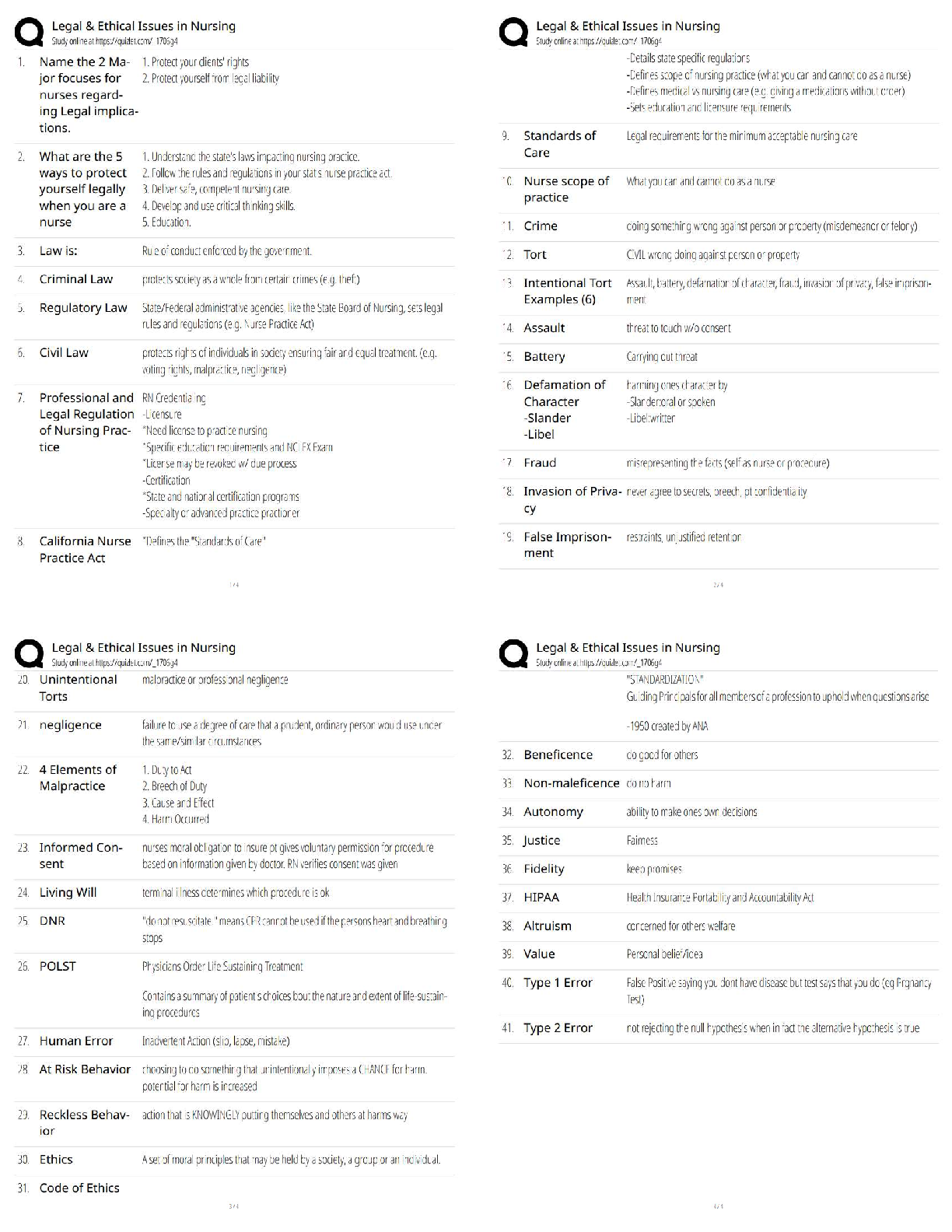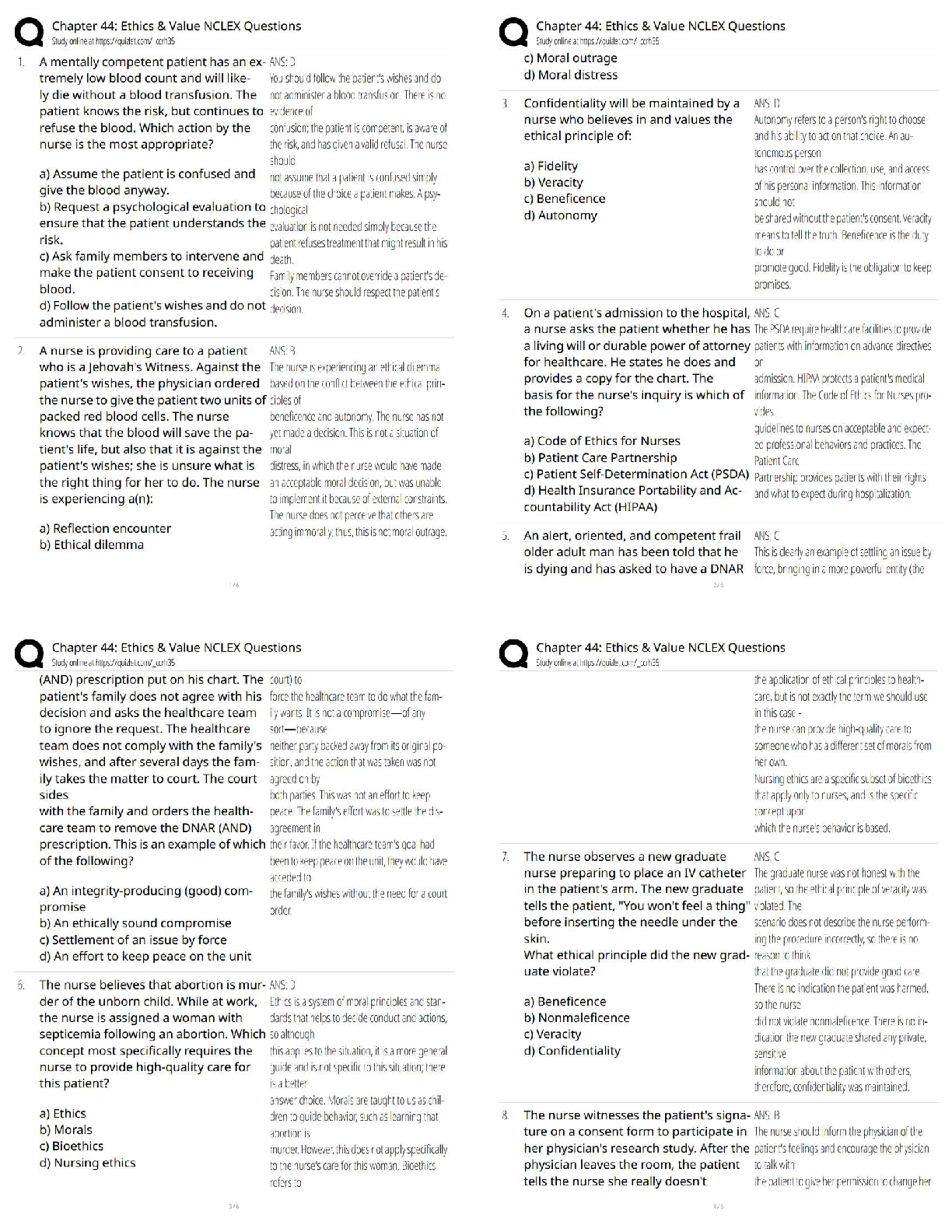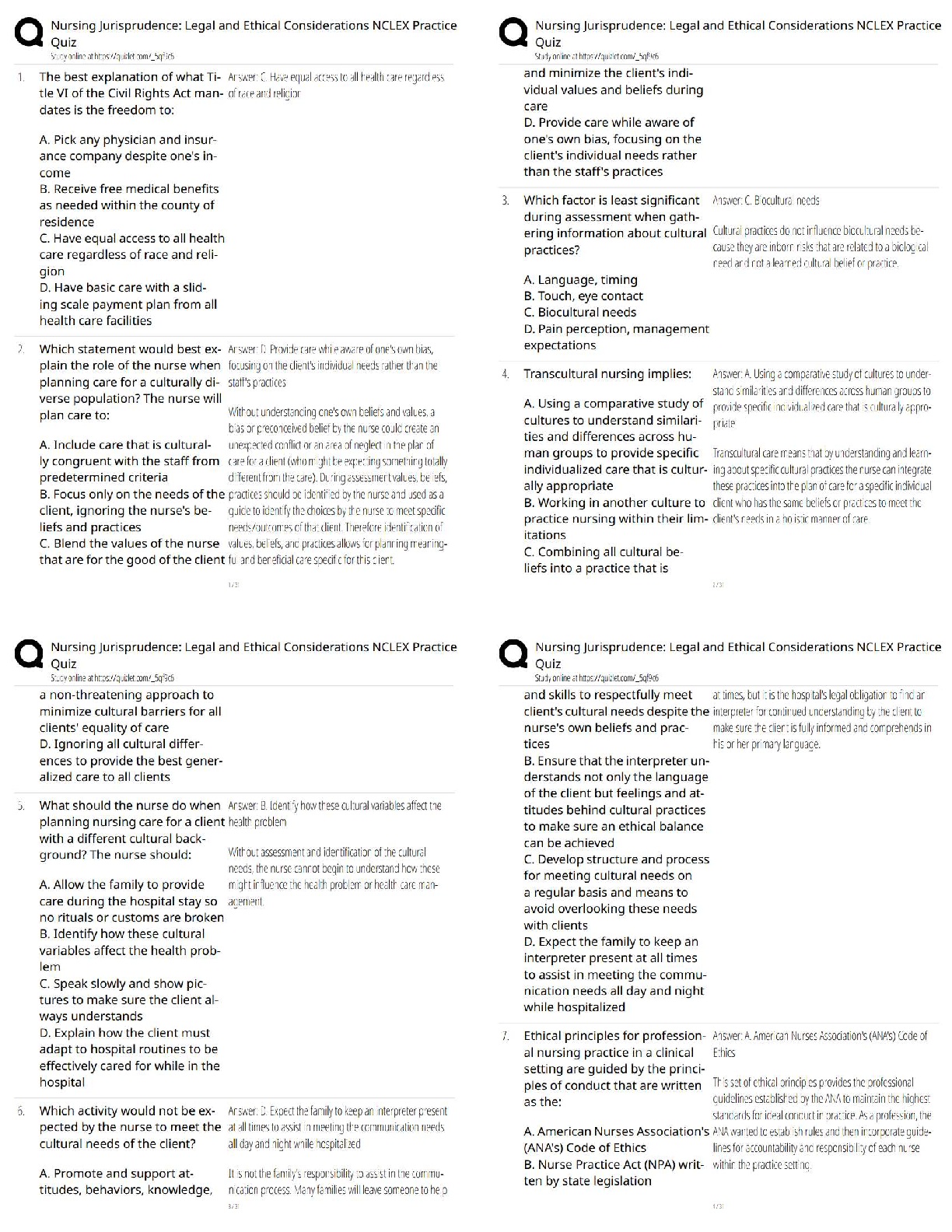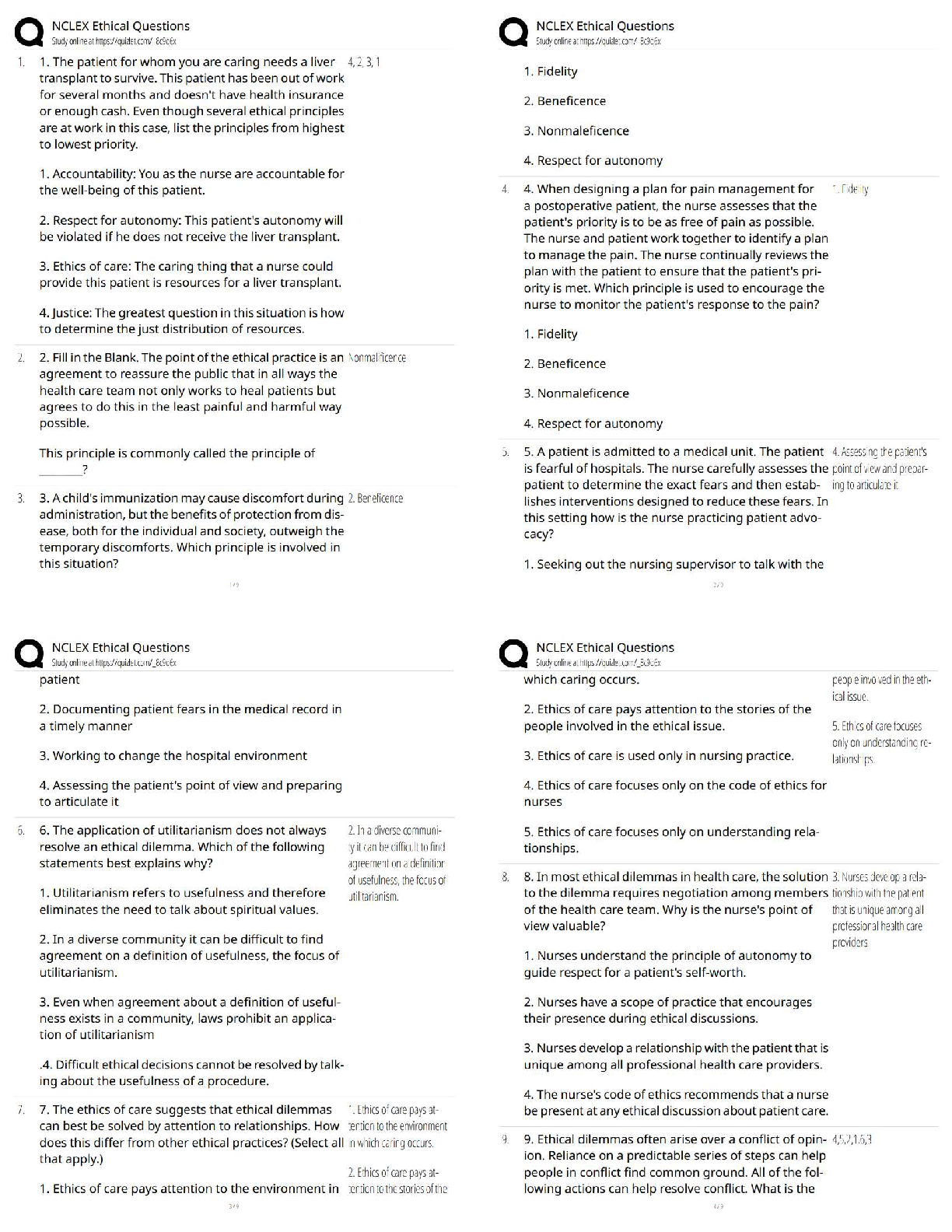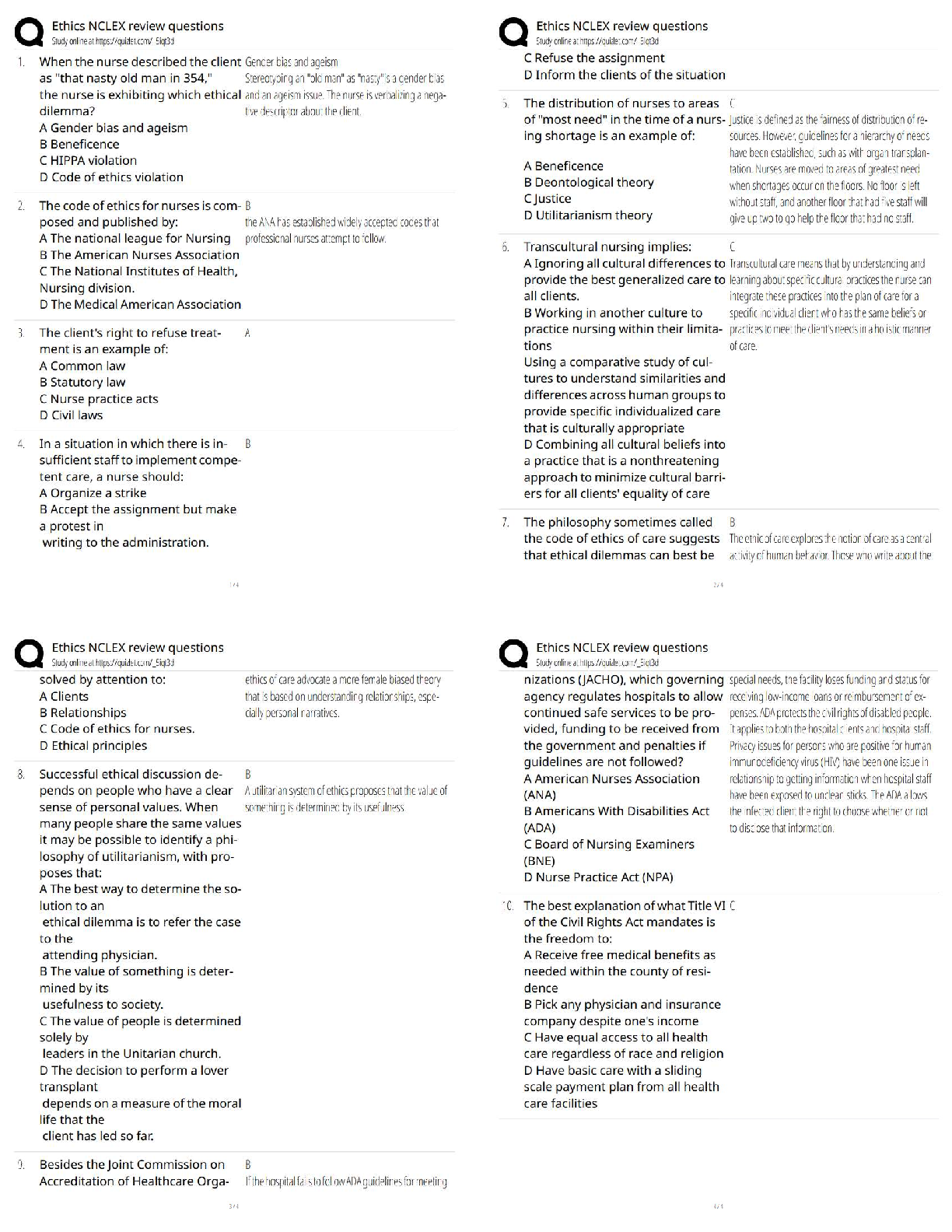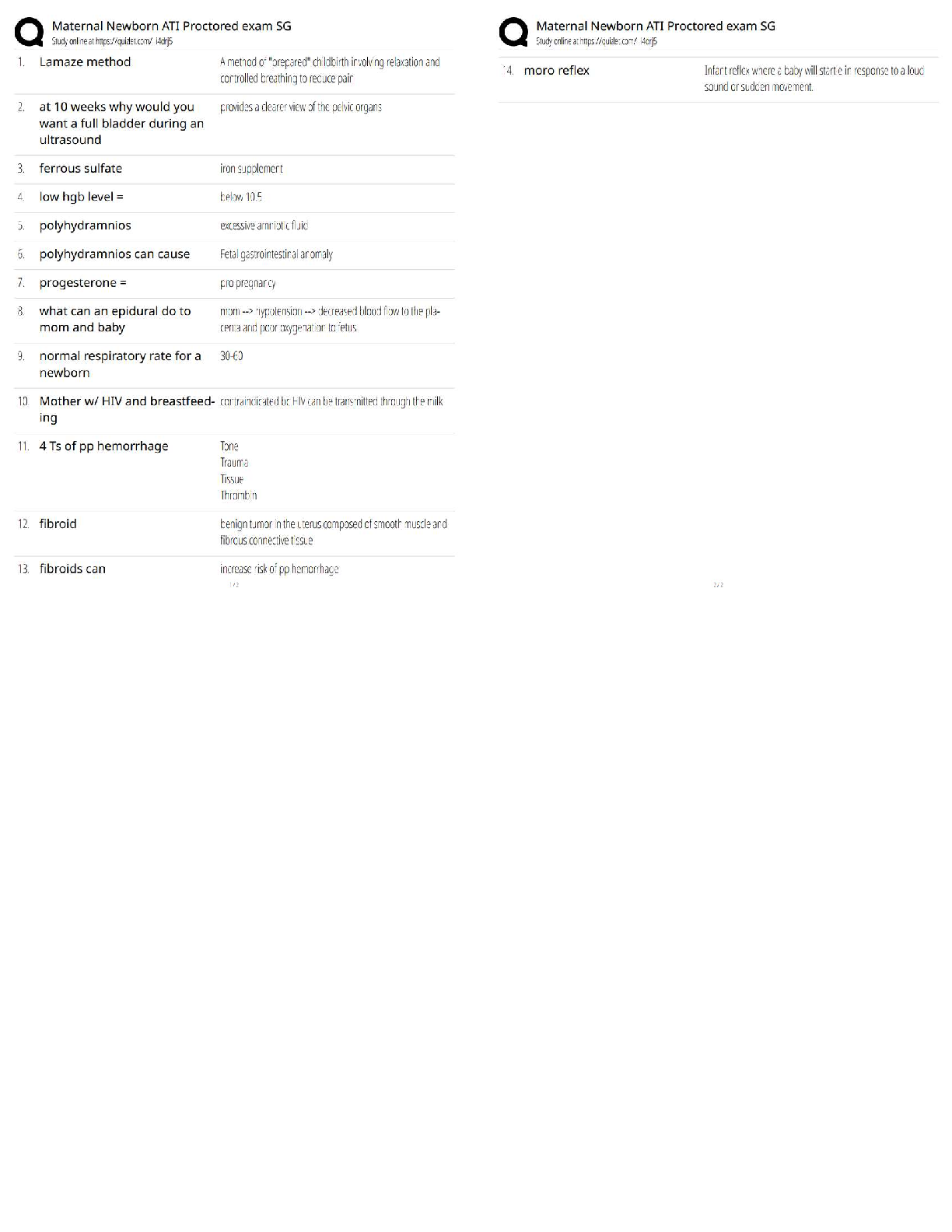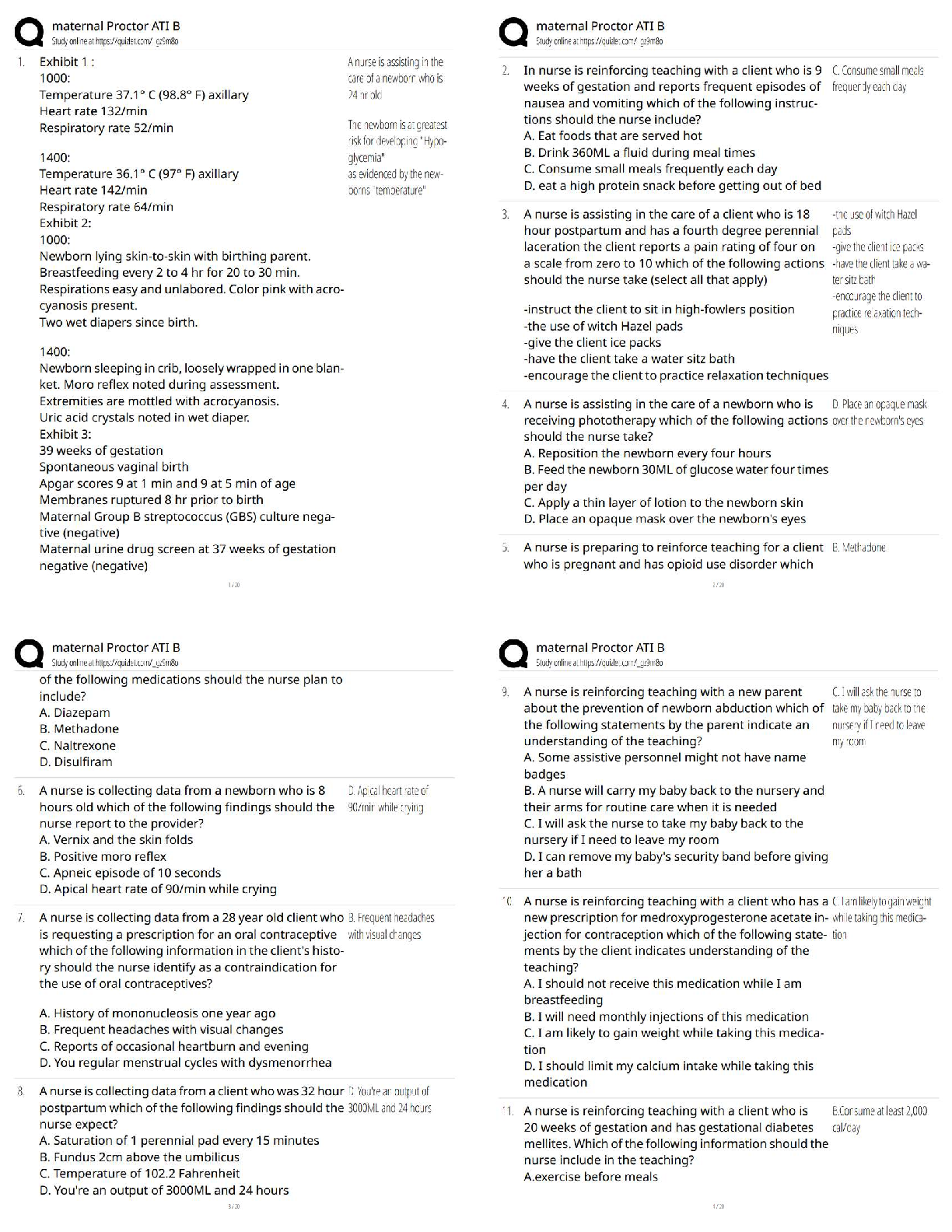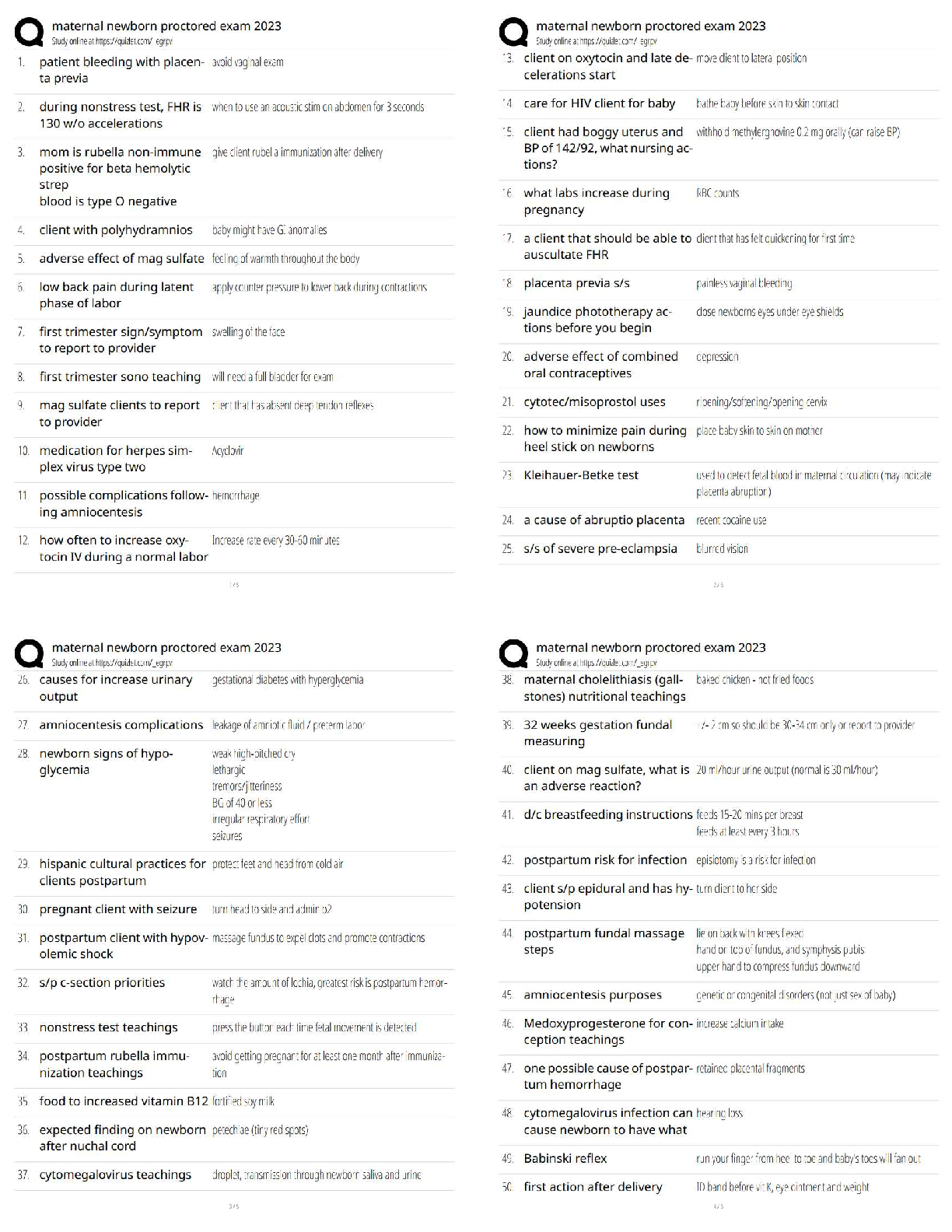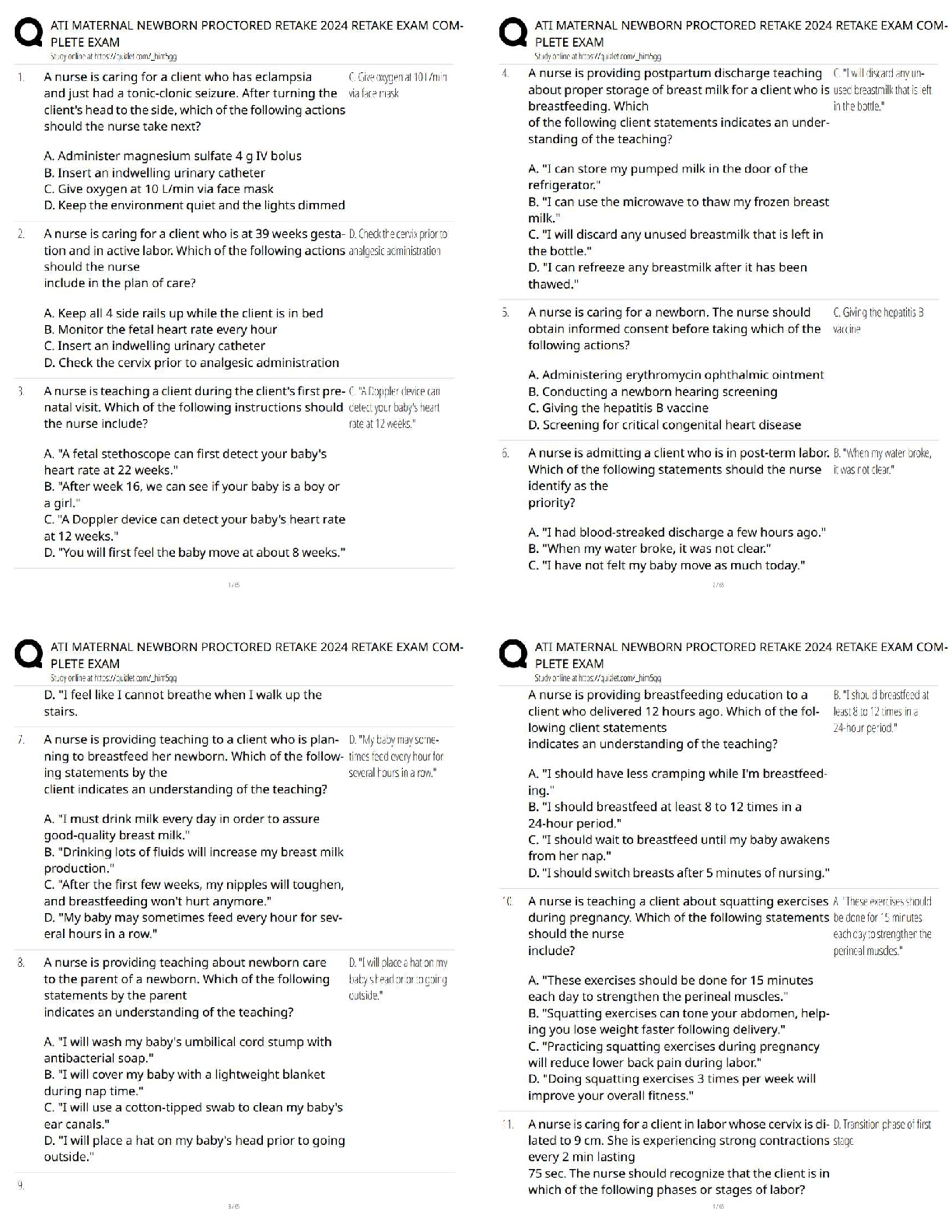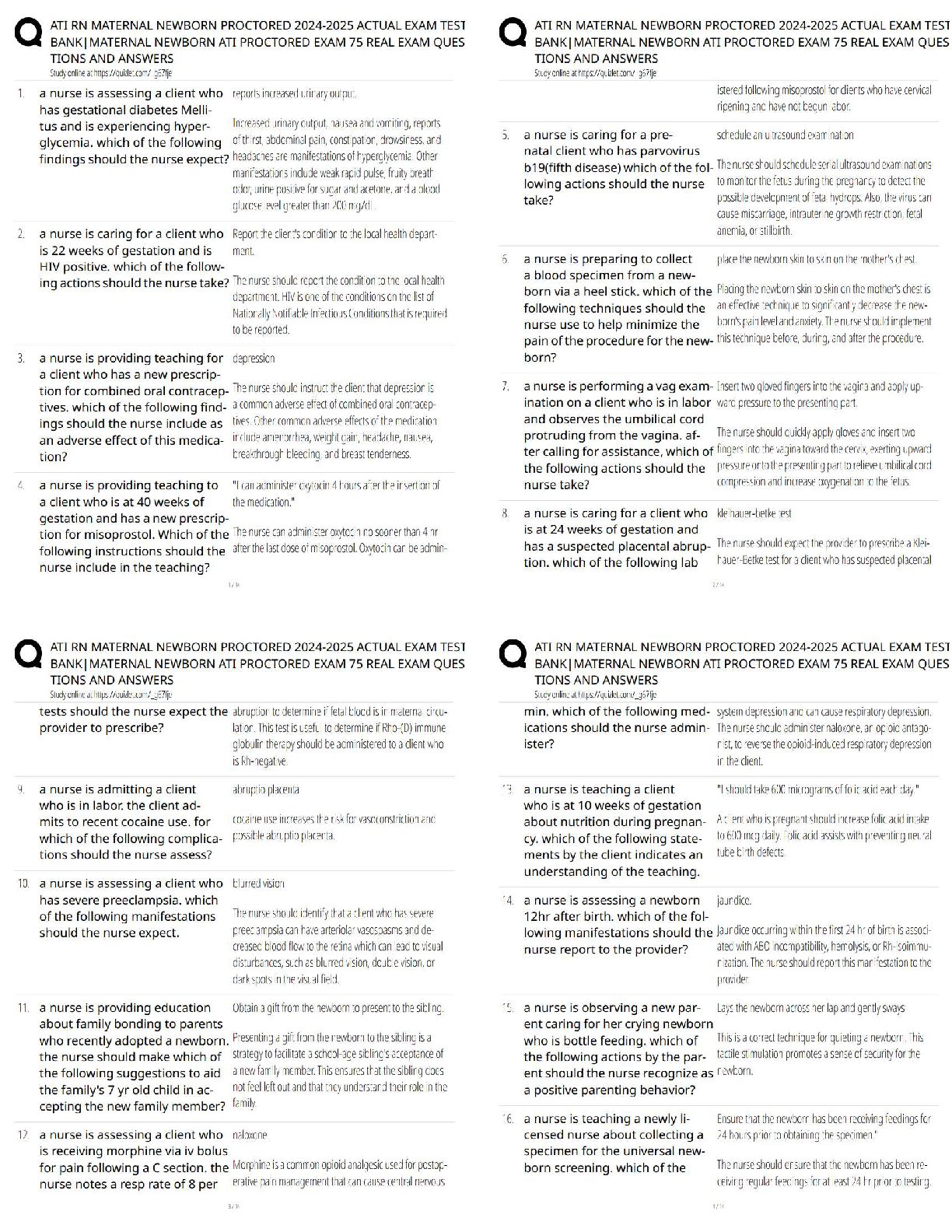*NURSING > QUESTIONS & ANSWERS > Knowledge Sytems Institute: Med Surg Comprehensive Study Notes With Questions, Answers and Rational (All)
Knowledge Sytems Institute: Med Surg Comprehensive Study Notes With Questions, Answers and Rationale. Exam ready Content
Document Content and Description Below
Characteristics of Cancer Cells Loss of proliferative control Normally there is balance between cell loss and cell production In cancer, cells reproduce haphazardly and continuously Pyramid effec ... t 1 >2>4>8>16 Doubling time: tumor doubles in mass Biochemical changes Cancer cells have abnormally large nuclei Synthesize proteins and glucose more readily than normal cells do Chromosomal instability Cancer cells have unstable chromosomes so that they mutate often Loss of ability to differentiate Cancer cell loses the ability to mirror the specific structure, function, and rate of division of the normal cell Protooncogenes regulate cell maturity genetic alterations cause protooncognes to become ONCOGENES > tumor inducing genes Cells regresses to fetal appearance and function Tumor Suppressor Genes regulate cell growth Genetic alterations decrease their tumor fighting ability Cancer Group of more than 200 diseases. Characterized by uncontrolled and unregulated growth of cells. Occurs in people of all ethnic groups and all ages. Elderly highest rates of cancer. Immunosenesence T cell function and Cell mediated immunity decreases. ONCOGENES tumor inducing genes Cell life cycle from M phase to M phase Chemo Meds works different cell cycles: GO Resting phase G1 RNA and protein synthesis begin S DNA synthesis G2 Further RNA/ protein synthesis M Mitosis Benign Tumor Encapsulated, Non recurring, Cells function like parent cells, Vascularity is usually low, Adjacent structures may be affected Metastatic Tumors : Metastasis The spread of tumor to other parts of the body Metastatic Tumors Malignant Neoplasm Characteristics, 1.Invasiveness, 2.Rapid growth, 3. Decreased contact inhibition, 4. Moderate to markedly vascular, 5. Poorly differentiated Development of Cancer Likely to be multifactorial, Origin of cancer may be, Genetic: breast, Chemical: lung, Environmental: skin, lung, Viral: HPV, Hep B, liver cancer, and HIV. Immunological: leukemia, autoimmune dis. Hormonal: breast, prostate. Unidentified causes. Risk Factors Associated With Cancer Age, Genetic predisposition, Poor immunologic system functioning, Hormonal factors, Tobacco Use/ Second hand smoke, Poor diet and nutrition: Hi fat diets and diets low in, antioxidants, Sun Exposure, Viruses, Precancerous lesions, Drugs, Chemicals, Radiation, Pesticides, Immunosuppressive drugs. ACS Screening Guidelines Breast: Annual mammogram for women over 40. Colon and rectum: > 50: yearly occult blood, sigmoidoscopy q 5 years; colonoscopy q 10 years. Prostate: >50 PSA. Uterus: PAP smear. TEST: 7 Warning Signs of Cancer Change in bowel or bladder habits, A sore that does not heal, Unusual bleeding or discharge from any body orifice, Thickening or a lump in the breast or elsewhere, Indigestion or difficulty swallowing, Obvious changes in a wart or a mole, Nagging cough or hoarseness. Prevention and Early Detection (Healthy People 2020) Limit alcohol use, Regular physical activity, Normal body weight, Regular colorectal screening, Avoid cigarettes and tobacco, Regular mammograms/PAP smear, Sunscreen factor 15 or >, Diet: reduce fat; increase fruit/vegetable. TEST: Prevent Skin Cancer , ABCDE Asymmetry, Benign:Symmetrical, Malignant: Asymmetrical. Border, Benign:Even edges, Malignant: Uneven edges. Color, Benign:One shade, Malignant: Two or More Shades. Diameter, Benign:Smaller than 6mml, Malignant: larger than 6 mm, Evolving. Benign:Any change in a mole's size, shape, color, evaluation on other trait, or bleeding, itchy or crusting, warrants further investigation Development of Cancer :Initiation Initiation: Mutation in the cell's genetic structure, May develop into a clone of neoplastic cells, Initiated cell may die or be destroyed by body defense system. Development of Cancer :Promotion Promotion : The reversible proliferation of genetically altered cells, Cancer prevention is useful at this stage. Development of Cancer :Latent period Latent period: May range from 1 to 40 years, Length of latent period associated with mitotic rate of tissue of origin and environmental factors. For disease to be clinically evident, tumor must reach a critical mass that can be detected. Development of Cancer:*Progression Progression:Increased growth rate of the tumor, increased invasiveness and metastasis, Metastasis process begins with rapid growth of primary tumor, Tumor develops its own blood supply, Critical for survival and growth of tumor, Tumor angiogenesis is formation of blood vessels within tumor, Certain segments of primary tumor can detach and invade surrounding tissues. Tumor angiogenesis is formation of blood vessels within tumor, Common Sites of Blood-born Metastasis 30% of patients with solid tumors have metastasis at the time of diagnosis. Most common sites of metastasis of solid tumors is the lung, liver, CNS and bone. Classification of Cancer Tumors can be classified by, Anatomic site: lung, breast, so on. Histology:Grading. example: epithelial, mesenchymal, neural. Extent of disease:Staging 1-4. Classification of Cancer Clinical staging classifications: 0: Cancer in situ, 1: Tumor limited to tissue of origin; localized tumor growth, 2: Limited local spread, 3: Extensive local and regional spread, 4: Metastasis. TESTStaging of Cancer TNM T T= the primary Tumor TX: can not be measured or found, TO: no evidence of a primary tumor, Tis: cancer in situ Early cancer that has not spread, T1-T4 tumor size and invasion into nearby tissues. TESTStaging of Cancer TNM N N= regional Node involvement NX: the nearby lymph nodes can not be measured or found, NO: nearby lymph nodes do not contain cancer, N1-N3 the size, location and/or number of lymph nodes involved. TESTStaging of Cancer TNM M M= distant Metastasis MX: Metastasis cannot be measured or found, MO: there are no known distant metastasis, M1: distant metastasis are involved, Note: Staging of cancer varies with the type of cancer Diagnosing Cancer Don't forget self exam. Testicular Self-exam, Breast Self-exam, after period. Definitive means of identifying cancer Needle biopsy, Incisional biopsy, Excisional biopsy, Tissue sampling during surgery. Cancer Treatment Modalities Surgery:First line for tumors that are solid or contained, Radiation Therapy:External or Internal, Chemotherapy:First line treatment for hematological tumors. Multimodality, Alternative, Complementary. 3 Surgical Therapy 1.Prevention, 2. Cure and control, 3. Supportive and palliative care. Surgical Therapy:Prevention Prevention. Surgery used to eliminate or reduce risk of cancer in at-risk patients. Prophylactic removal of nonvital organs is successful treatment for certain malignancies. Usual sites of regional spread may be removed. Surgical Therapy:Cure and control Cure and control. Remove only as much tissue as necessary, and spare normal tissue. Good prognostic indicators include : Small tumor size; Clean tissue margins; Absence of lymph node involvement and abnormal tumor marker values Surgical Therapy:Supportive and palliative care Supportive and palliative care Cure or control is not possible. Preserving quality of life. Supportive care includes: Gastric tube, colostomy, supropubic cystostomy, vascular access device; laminectomy to relieve cord compression Debulking of tumor or radiation therapy to relieve pain or pressure. Radiation Radiation therapy emissions damage the cancer cell's DNA. Damaged DNA prevents cancer cell division and growth causing the tumor to shrink. Targets specific well defined tumors. Uses of Radiation Inoperable lung or bronchus cancer, Head/ neck tumors, Breast tumors, Shrink tumors, Radiation Therapy External radiation: Teletherapy, Internal radiation: Brachytherpay. External radiation - Teletherapy Most common,S kin protection Patient exposed to radiation from a megavolt machine. S.E.: Wash skin gently, pat dry; Soft, non restrictive clothing, Avoid intense sun. Internal radiation - Brachytherapy, Private room, Visitors: 6 ft away/30 min, Implanted radioactive seeds, Pt is emitting radioactivity, Limit time and distance, Organize care, Dosimeter film badge. Potential Complications::Myelosuppresion Myelosuppresion can occur as a result of: Cancer, Chemotherapy, Radiation therapy, Biologic therapy, Immunosuppressant therapy (after transplants). Myelosuppresion results in:, Anemia Neutropenia, Thrombocytopenia. Leukopenia and Neutropenia Lab Values WBC 5,000 - 10,000cells/mm3 Decrease in WBCs = leukopenia Neutrophils 4,000 -11,00 cells/mm3 60% of WBCs First line of the body's defense against infection Neutrophils initiate the inflammatory response Engage in phagocytosis Neutropenia Cell count is 1000 - 1500 cells/mm3 Severe neutropenia < 500 cells/mm3 The patient must be placed on neutropenic precautions Treatment of neutropenia Hematopoietic growth factors Granulocyte-macrophage colony stimulating factor (GM-CSF) Granulocyte colony stimulation factor (pG-CSF) These are given sq or IV Neutrapenic Precautions Handwashing patients and visitors Wash all surfaces or your hands for a minimum of 15 seconds with antibacterial soap. Avoid fresh fruits, vegetables, flowers, dried flowers, and live plants. Avoid people recently vaccinated Avoid pet excreta (no cleaning of litter boxes, fish tanks, turtle bowls) Avoid people who have a transmissible illness (chicken pox, herpes zoster, influenza, colds. Use good personal hygiene: hand washing, daily bathing, and mouth care after meals/bedtime, perineal care after toileting. Wear a face mask outside your home or room Use high efficiency particulate air (HEPA) filters to clean the air. If HEPA filter is used in a room the doors should be kept closed. Neutrapenic Precautions Maintain skin integrity. Prevention constipation. Use lubricant during sexual intercourse. Maintain optimal respiratory function Exercise as tolerated Turn, cough and deep breathing exercises Incentive spirometer Report signs of infection Temperature greater than 38 degrees Celsius Shaking chills Pain when urinating Pain when breathing Respiratory congestion or productive cough Anemia: Decrease in Red Blood Cells Red blood cells are important because of their oxygen carrying capacity Signs and symptoms of anemia SOB, tachycardia, Weakness Fatigue Treatment of anemia Transfusion with Red blood cells Transfusion of the immunosuppressed patient requires special precautions Using leukocyte poor blood Premedicate patient with Tylenol and Benadryl to prevent transfusion reactions Use of erythropoietin to stimulate the production of red blood cells Erythropoietin: Epogen, EPO, Procrit Given IV or sq Major adverse reactions: Seizures, HTN Management of Fatigue Appropriate Rest Hi protein diet Nutritional supplements Vitamins Iron Thrombocytopenia: low platelet level Thrombocytes are important in blood clotting Normal platelet count 150,000- 450,000/mm3 Thrombocytopenia 40,000-60,000/mm3 Risk of spontaneous bleeding when the count is less 20,000/mm3 Thrombocytopenia: low platelet level Petechiae: Small, flat reddish or purple spots that appear on the skin Easy bruising Oozing from blood or other tissues Frank bleeding Thrombocytopenia: low platelet level Nursing Interventions Nursing Interventions Fall precautions Avoiding potentially traumatic injuries (athletics) Soft toothbrush Safety razor Thrombocytopenia: low platelet level Treatment Treatment Platelet transfusions Neumega Neumega is a thrombopoetic growth factor Neumega stimulates the production of platelets Given sq Main side effect is Fluid Volume Excess Gastrointestinal Complications Nausea and vomiting Symptoms: increase in respirations, increased heart rate, dilated pupils and pallor, decreased gastric motility Vomiting is a less common with newer chemotherapy drugs Consider medicating patient one half to one hour before chemo begin Anticipatory vomiting: begins before the treatment starts and can be treated with antianxiety medications such as Nausea and vomiting Nursing Consideration Mouth care Manage anticipatory vomiting Liberal use of antiemetics Ondansetron (Zofran) is antiemetic of choice IV or po Rate: May administer IV undiluted over 2-5 minutes Common side effects include headache, constipation and diarrhea Monitor for fluid and electrolyte imbalances Monitor for alterations in nutrition Consider amnesiacs, tranquilizers, and psychotropic mediations as part of overall antiemetic regime Gastrointestinal Complications Diarrhea Nursing Interventions Monitor for fluid and electrolyte imbalances Administer antidiarrheals Eat small, frequent meals Low residue diet: Increases absorption and decreases bowel irritation Low residue foods: bananas, applesauce, white rice, noodles, broth, gelatin, white bread Drink 3,000 ml of fluid per day. Drink Gatorade, flat carbonated beverages Avoid caffeinated beverages Consider TPN if the diarrhea is severe, persistent and there is evidence of weight loss Mucositis Mucositis is a general term describing inflammation of the mucous membranes Stomatitis Stomatitis refers to inflammation of the mouth including lips and tongue. Mucositis/Stomatitis Common side effect of cancer and cancer treatments Nursing diagnosis: Alterations in mucous membrane Mucositis/Stomatitis:Pathophysiology Pathophysiology Normally cells of the epithelial layer of the mucous membranes are replaced every 7-14 days Mucosal thinning or ulcerations occur when the rate of cell loss is greater than the rate of cell renewal Mucositis/Stomatitis:Signs and Symptoms Signs and Symptoms Dry, cracked, ulcerated and bleeding lips Drying of the mucous membranes of the mouth with redness, swelling, and ulcerations Increased saliva at first, Then decreased saliva Patient refuses to eat due to pain In severe causes intubation may be necessary to protect the airway due to impaired swallowing Mucositis/Stomatitis:Nursing Interventions Nursing Interventions Assess oral cavity, swallowing ability, quality of voice Meticulous oral care as frequently as every 2 hours to prevent infection Oral antifungals as needed Nystatin swish and swallow Clotrimazole troche (allow to dissolve in the mouth) In severe causes: Intravenous antifungals may be needed Fluconazole Amphotericin Comfort measures Planning tolerable meals Nutrition Alterations in Nutrition Anorexia: loss of appetite Cachexia: progressive loss of body weight, loss of muscle mass, hypoalbuminemia, anemia. Loss of taste Nursing Interventions Dietary consult Nutritional supplements Appetite stimulants Megestrol (Megace) Hormone, progestin Watch out for development of DVT Dronabinol (Marinol) Antiemetic and appetite stimulant THC derivate Side effects are dizziness and light headedness Weight gaining strategies Small, frequent meals Eat foods high in calories and protein Hi protein shakes and snacks Nutritional supplements Monitor and record weight Calorie count Glass of wine to stimulate appetite TPN if other options fail Psychosocial Issues Alterations in Sexuality and Body Image Altered body image due to removal of body parts, loss of hair, changes in skin color due to radiation treatment Pain with sexual activity due to mucositis Decreased libido Nausea and vomiting Chemotherapy, surgery, radiation therapy and certain types of cancer can cause sterility Alterations in family dynamics Sperm or eggs can be stored for future use if the cancer treatment will result in sterility Support groups, counseling for the family Breast Cancer Breast Cancer Breast CA Risk Factors Female 99%, Family history of breast Ca, History of previous breast cancer, Early menarche, Late menopause, First pregnancy after age 30, Childless women, Exposure to radiation, Advanced age. Breast CA Risk Factors High-fat diet /Obesity, Prolonged use of oral contraceptives, Hormone Replacement Therapy, Cigarette Smoking, Toxic chemical exposure, Toxic drug exposure, Electromagnetic fields. Signs and Symptoms Painless lump, Irregular, Firm to hard in consistency, Fixed, Retraction or dimpling of breast skin or nipple, Peau d'orange appearance of skin, Palpable axillary nodes, Nipple discharge, Warm, red, tender breast, 50% of cancer in upper outer quad. Pathophysiology Tumors of the breast arise in the epithelial cells of ductal or lobular tissue. Epithelial cells are continually generated by the basal membrane. interference. Cell DNA is modified. Growth factors: estrogen and progesterone accelerate transition from premalignant to malignant cells. Changes in oncogenes. Loss of tumor suppressor genes. Histological Classification of Breast Cancer; Non Invasive Non Invasive, Ductal Carcinoma in Situ, 40-60% will develop malignancies, Lobular carcinoma in situ. Histological Classification of Breast Cancer: Invasive Invasive, Infiltrating ductal Carcinoma 80%, Unspecified most common, Medullary carcinoma, Inflammatory breast cancer 3%, Mucinous carcinoma, Paget's Disease: rare affects nipple. Do it breast self-exam every month.. when? after period Diagnostic Screening Breast self-examination (BSE), 80-95% of all breast lesions are self detected, Performed monthly after menses, Clinical Breast Exam (CBE), ACS, 20 - 40 q 3 years, >40 yearly, Mammography: Yearly for women over 40, Detects tumors before they become palpable < 1 cm. Prognostic Factors at time of Diagnosis Invasiveness, Grade: metastatic potential, Lymph node involvement, Tumor size, Tumor proliferation, Estrogen and progesterone markers, Genetics: c-erB-2/HER-2/neu proto-oncogene associated with poor prognosis, Note: Tumor proliferation- how fast tumor is growing. Estrogen/progesterone markers 60% of breast cancers are ER positive and responsive to hormonal management. Staging and Histology Lymph Node Biopsy: Staging: T = primary tumor, N = regional nodes, M = metastasis, Stage Grouping; Stage I - IV. Biomarker Tests Estrogen receptors, Progesterone receptors, RX: Tamoxifen and Raloxifene. Nonsteroidal drug that competes for the estradiol bonding site on the ER -positive cell. Human epidermal growth factor receptors 2 (HER2/neu) RX: Herceptin Types of Surgery Lumpectomy, Quadrectomy, Simple mastectomy, Radical mastectomy. Pre-Op MD lab orders MD orders CBC, Liver Function Tests, Chem 12, Calcium levels, CXR, Bone scan. Post Op Report Report Example T2 Tumor > 2 cm < 5 cm. Tumor size and invasion into near by tissues.. N2 Metastasis to ipsilateral axillary lymph nodes fixed to one another. M0 No distant metastasis. Stage III Cancer. Plan: Chemotherapy 6 weeks after surgery. Post Op Nursing Diagnoses Acute Pain, Risk for Infection: Assess for fluid collection in the chest wall and axillary node dissection site for S&S of infection, Impaired physical mobility of arm and shoulder, Body image disturbance r/t surgery, Acute grief r/t cancer diagnosis and loss of breast. Sample calculation of the ANC WBC count: 6,000 cells/mm3 of blood Segs: 30% of the WBCs Bands: 3% of the WBCs Neutrophils (segs + bands): 33% of the WBCs ANC: 33% X 6,000 = 2,000/mm3 ANC of 2,000/mm3, by convention = 2.0 Normal range: 1.5 to 8.0 (1,500 to 8,000/mm3) Hold chemotherapy less than 1.0, risk for infection. PC: Lymphedema, SxS S&S: Pain, swelling, numbness, infection, decreased strength PC: Lymphedema, Teaching Teaching; Measure arm circumference, Elevate extremity, Avoid infection, Avoid burns, Avoid constriction. PC: Lymphedema, Skin care Skin care: Use of compression garments, Manual decompression, Arm exercises to maintain circulation and mobility. Cosmetics and Reconstructive Surgery Prosthetics, Breast Implants, Latissimus dorsi reconstruction, Traverse rectus abdominis, myocutaneous (TRAM) flap surgery. Reach for Recovery -American Cancer Society Cosmetics and Reconstructive Surgery R/T Nursing Dx Ineffective tissue perfusion r/t compromised circulation and compromised lymphatic drainage post TRAM flap breast reconstruction Radiation Therapy Common RX after lumpectomy surgery for early stage breast cancer. Considerations: Fatigue, Skin irritation [Show More]
Last updated: 3 years ago
Preview 1 out of 240 pages
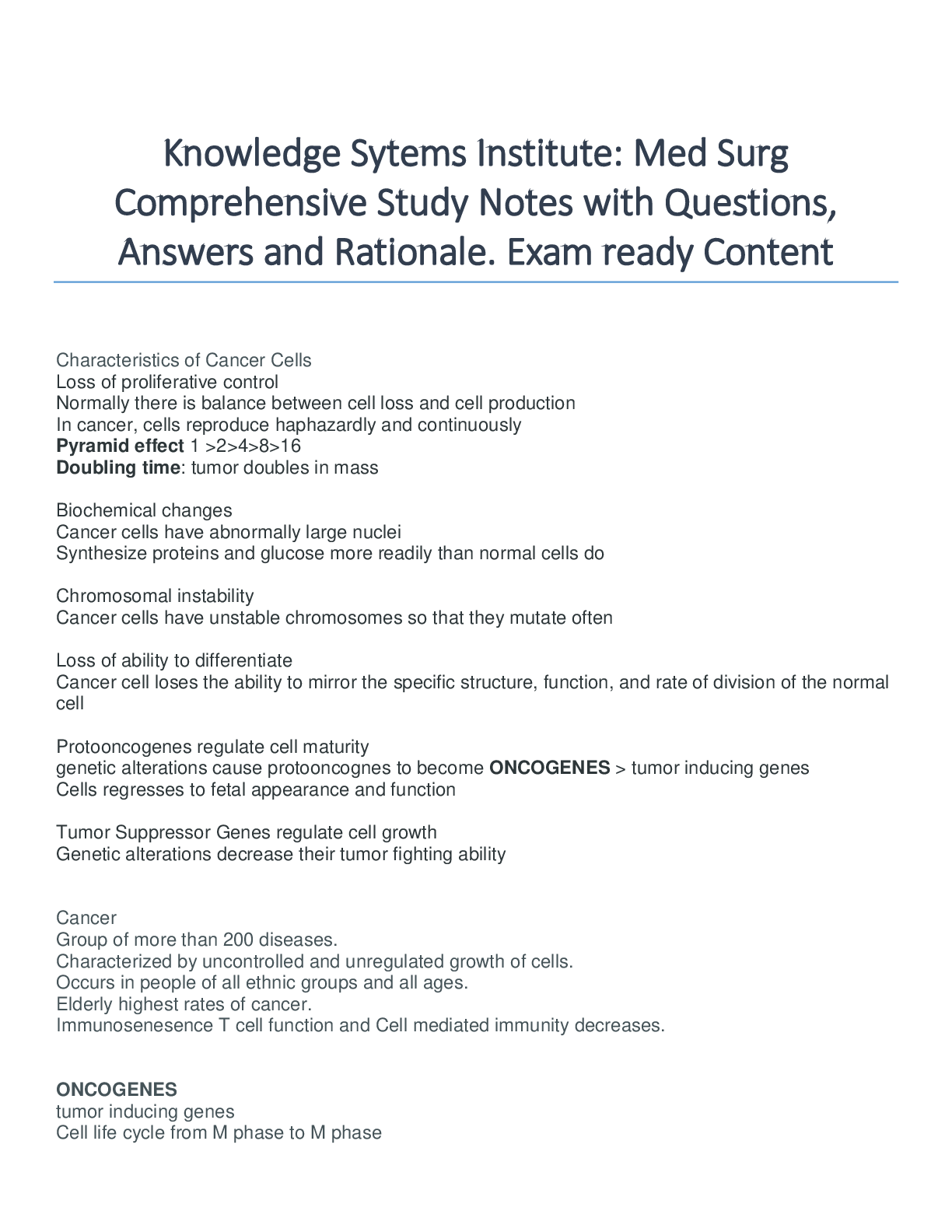
Buy this document to get the full access instantly
Instant Download Access after purchase
Buy NowInstant download
We Accept:

Reviews( 0 )
$11.00
Can't find what you want? Try our AI powered Search
Document information
Connected school, study & course
About the document
Uploaded On
Jun 19, 2020
Number of pages
240
Written in
All
Additional information
This document has been written for:
Uploaded
Jun 19, 2020
Downloads
0
Views
94


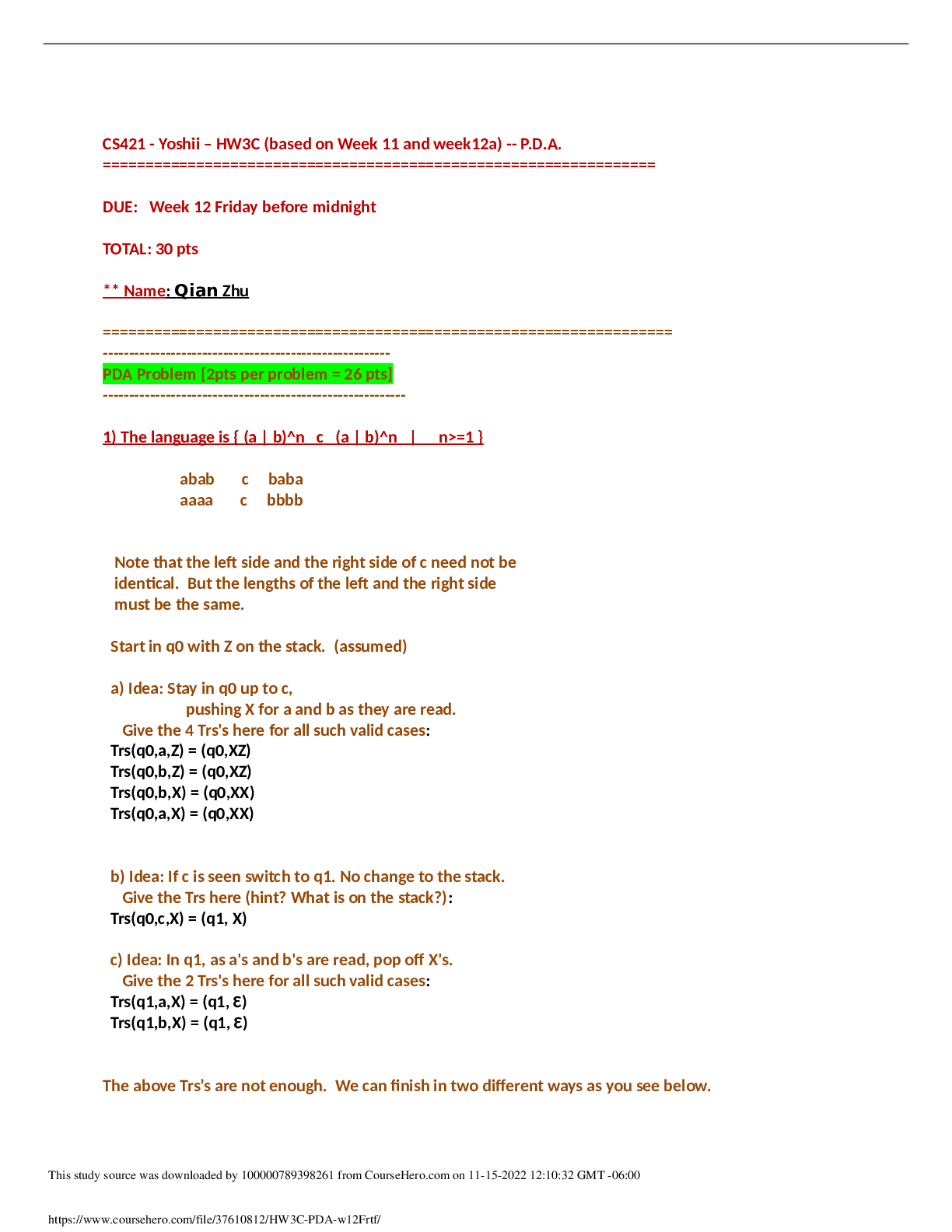


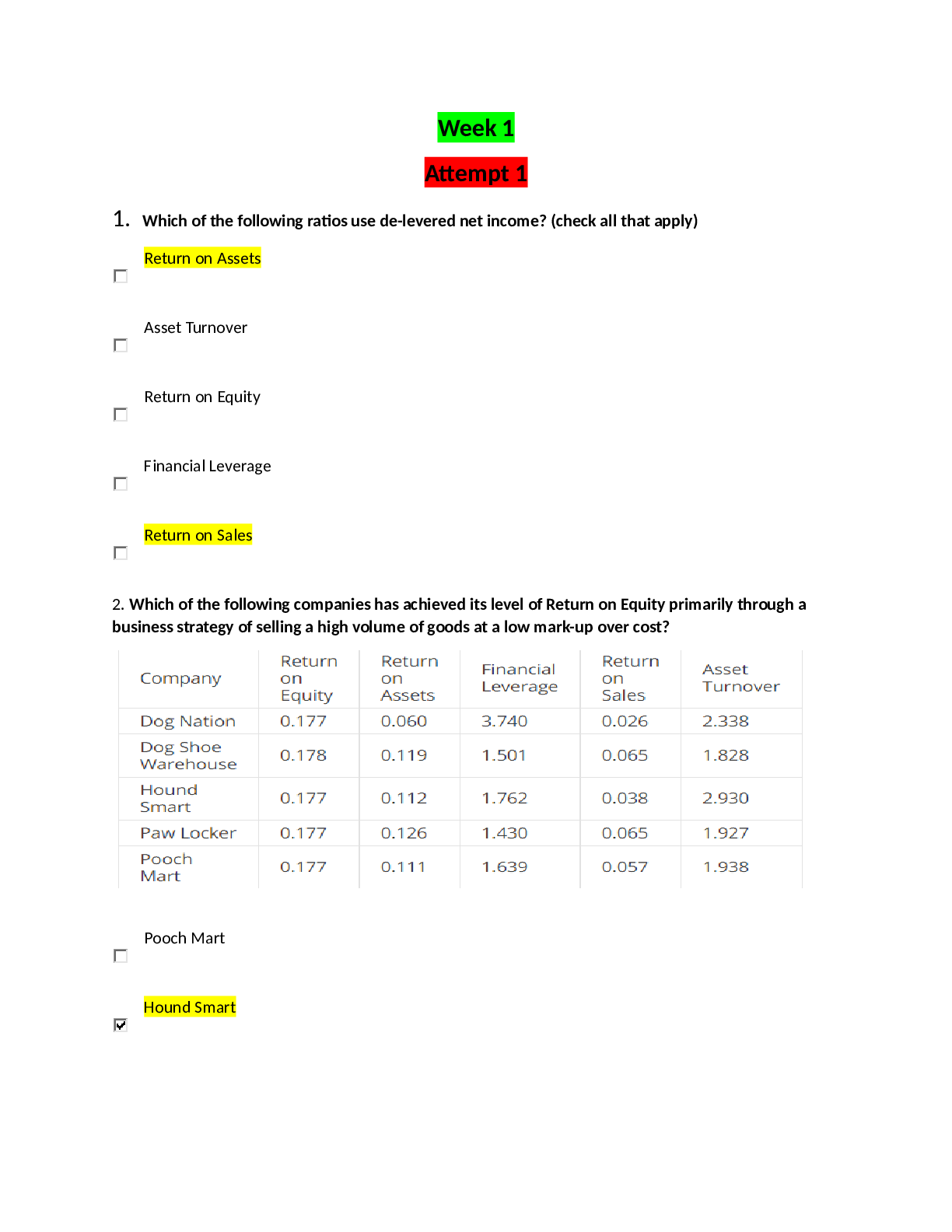
.png)
.png)
.png)
.png)
.png)
.png)
.png)
